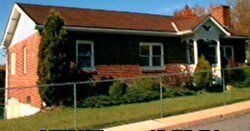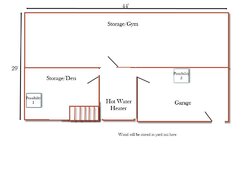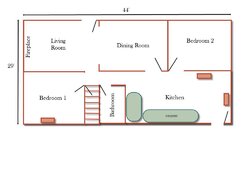Hi everyone,
I'm new here and pretty much clueless. I just purchased my first home (1276sq ft) in October and it has electric heat and an open brick fireplace. To save on electricity, I have scrambled to get some wood and have been using the fireplace while home to cut down on the electric heat.
So all summer I want to cut and split and wood and install a wood stove so I am better prepared for next winter. I am going to be installing a All Nighter stove that was purchased by my father back in the 70's. I have to measure the firebox but I am pretty sure it is the Mid Mo'.
I have decided I want it in the basement. I just don't have a spot I would like it upstairs. With the house being small, space is kind of at a premium. Also, the 2 rooms in the basement I'm considering have solid concrete floors with block walls so I wouldn't have to worry about combustible materials.
Below I have included a drawing I made with the layout of the house and the possible locations I was considering placing the wood stove in. Understand that even though the basement is finished, little to no time is spent down there in the winter. I mostly just go down there to work on the occasional woodworking project in the garage or to re-arrange storage of Christmas decorations/etc. I also enter and exit the house through that level sometimes.
I am figuring I will remove the door that leads down the staircase to the basement in the winter to let the warm air find its way up the stairs. Note from the drawing that the staircase goes down, hits a landing, and turns 90 degrees. I was also planning on cutting numerous vents in the floor to allow the warm air from the basement to rise through the vents to the main level.
I am still planning on occasionally burning the open fireplace in subsequent winters just not as much since so much heat is lost.
Things to rememeber:
Garage is the only room on that level that does not have insulated walls
Kitchen is coldest room on the living level because of this; It is directly over the garage.
Bedroom 2 is currently unoccupied and not a concern for heat
Now, pros and cons I can think of for placement possibility 1:
Pros
- Chimney will be relatively easy to run outside the wall
- This room has the staircase that leads up to the main level so heat source will be closer to the stairs
- Directly under bedroom so would keep bedroom fairly warm
- Closer to get to from main level so going down to check/stoke fire will involve a shorter trip.
- This room stays warmer than the garage so less heat will be wasted if I keep door to garage closed
- Have less qualms about taking up floor space in this room than the garage.
Cons
- exterior chimney
- worried if enough heat will make it into the kitchen if the stairs are the only means of bringing heat up
- If door to garage kept open to reach kitchen vents will too much heat be wasted heating the ice cold garage.
- Chimney will be on exterior wall at the lowest pitch of the roof. Will have to extend pretty high making cleaning more difficult and dangerous.
Now, pros and cons I can think of for placement possibility 2:
Pros
- Directly below the large, cold kitchen
- vents in garage would heat kitchen directly above it
- inside chimney utilizing the closet in the 2nd bedroom on the first level
- chimney would exit right next peak on roof making cleaning easier/safer.
- Wood would be stored right outside garage door, shorter distance to bring wood inside
- garage would be warm for any projects I decide to do down there.
Cons
- Garage walls are not insulated, more heat loss
- Heat would have to travel through numerous door ways to find its way to the stair case
- Stove would be farther away to go check on/stoke
- would take up floor space in my already small garage
So, am I on the right track here? Am I way out in left field on this one? What would you do in my shoes?
I appreciate any advice you guys can give me. Also, I've been told to expect to clean the chimney about once a month throughout the winter, does that sound about right? I have to read up on what I need to clean the chimney because I'm clueless on that as well.
I have attached an older picture of the house as well as the layouts I've drawn.
I'm new here and pretty much clueless. I just purchased my first home (1276sq ft) in October and it has electric heat and an open brick fireplace. To save on electricity, I have scrambled to get some wood and have been using the fireplace while home to cut down on the electric heat.
So all summer I want to cut and split and wood and install a wood stove so I am better prepared for next winter. I am going to be installing a All Nighter stove that was purchased by my father back in the 70's. I have to measure the firebox but I am pretty sure it is the Mid Mo'.
I have decided I want it in the basement. I just don't have a spot I would like it upstairs. With the house being small, space is kind of at a premium. Also, the 2 rooms in the basement I'm considering have solid concrete floors with block walls so I wouldn't have to worry about combustible materials.
Below I have included a drawing I made with the layout of the house and the possible locations I was considering placing the wood stove in. Understand that even though the basement is finished, little to no time is spent down there in the winter. I mostly just go down there to work on the occasional woodworking project in the garage or to re-arrange storage of Christmas decorations/etc. I also enter and exit the house through that level sometimes.
I am figuring I will remove the door that leads down the staircase to the basement in the winter to let the warm air find its way up the stairs. Note from the drawing that the staircase goes down, hits a landing, and turns 90 degrees. I was also planning on cutting numerous vents in the floor to allow the warm air from the basement to rise through the vents to the main level.
I am still planning on occasionally burning the open fireplace in subsequent winters just not as much since so much heat is lost.
Things to rememeber:
Garage is the only room on that level that does not have insulated walls
Kitchen is coldest room on the living level because of this; It is directly over the garage.
Bedroom 2 is currently unoccupied and not a concern for heat
Now, pros and cons I can think of for placement possibility 1:
Pros
- Chimney will be relatively easy to run outside the wall
- This room has the staircase that leads up to the main level so heat source will be closer to the stairs
- Directly under bedroom so would keep bedroom fairly warm
- Closer to get to from main level so going down to check/stoke fire will involve a shorter trip.
- This room stays warmer than the garage so less heat will be wasted if I keep door to garage closed
- Have less qualms about taking up floor space in this room than the garage.
Cons
- exterior chimney
- worried if enough heat will make it into the kitchen if the stairs are the only means of bringing heat up
- If door to garage kept open to reach kitchen vents will too much heat be wasted heating the ice cold garage.
- Chimney will be on exterior wall at the lowest pitch of the roof. Will have to extend pretty high making cleaning more difficult and dangerous.
Now, pros and cons I can think of for placement possibility 2:
Pros
- Directly below the large, cold kitchen
- vents in garage would heat kitchen directly above it
- inside chimney utilizing the closet in the 2nd bedroom on the first level
- chimney would exit right next peak on roof making cleaning easier/safer.
- Wood would be stored right outside garage door, shorter distance to bring wood inside
- garage would be warm for any projects I decide to do down there.
Cons
- Garage walls are not insulated, more heat loss
- Heat would have to travel through numerous door ways to find its way to the stair case
- Stove would be farther away to go check on/stoke
- would take up floor space in my already small garage
So, am I on the right track here? Am I way out in left field on this one? What would you do in my shoes?
I appreciate any advice you guys can give me. Also, I've been told to expect to clean the chimney about once a month throughout the winter, does that sound about right? I have to read up on what I need to clean the chimney because I'm clueless on that as well.
I have attached an older picture of the house as well as the layouts I've drawn.





 ! Tim
! Tim